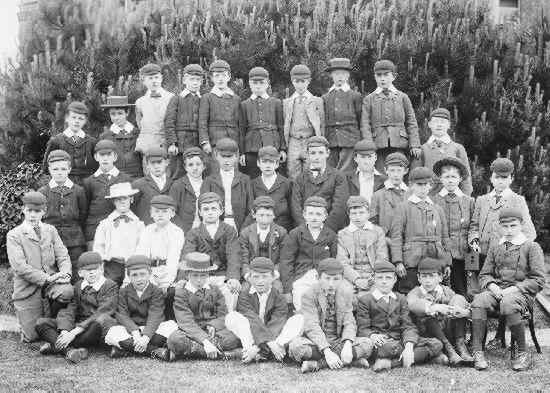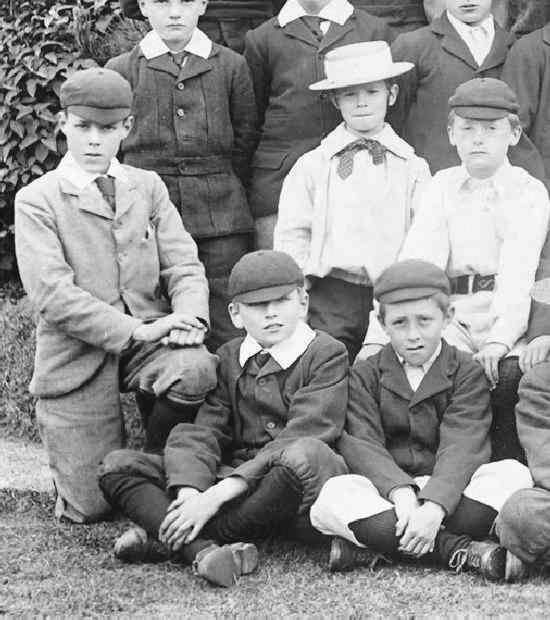
English School Uniform: Individual School -- Suffield Park School

Figure 1.--This photograph shows the boys at Suffield Park School. We think this might be a portrait of the entire school, rather than a form or house, but we are not positive. Some of these schools in the 19th century were quite small, so it could be the full school. The portrait was taken in the 1890s, but we are not sure about the year.
|
Suffield Park School was a preparatory school located in Cromer, Norfolk. HBC is not sure about the current status of the school. A portrait taken in the late 1890s illustrates that there was no actual uniform for these privileged boys but they did maintain a certain "style" asmost boys wore Norfolk suits--rather appropriate considering the location of the school.
The School
Suffield Park School in the 1890s appears to have been a preparatory school. We are not sure when it was founded. We have no subsequent information on the school. We do note that there is now a Suffield Park Infant & Nursery School. Presumbly the preparatory school evolved into the current nursery school.
Location
The school is located in Cromer in Norfolk. Norfolk is the northern part of East Anglia located northeast of London.
The Portrait
This is a portrait taken by a professional photographer. The photographer was by Mace & Mase of Cromer. Interestingly none of the mdsters are photographd with the boys, which was a common convention. We thought this might be a portrait of the entire school, rather than a form or house, but we are not positive. Some of these schools in the 19th century were quite small, so it could be the full school. Usually form portraits are obvious because the boy are about the sme age. The number of boys here looks to be more than a school would have in one form. There looks to be some age difference, but not as great as one might expect to find in a full school portrait of a preparatory school. A HBC reader reports, "I wouldn't have thought it was the entire school. The boys all look around the same age. I
believe that boys usually went away to prep-school at around 8 years and went onto public/private school at around 13. These boys look like they might be in their final year at this school and perhaps that is the reason for the photograph." HBC agrees that the boys do not look to be the normal 8-13 year prep school age range, but we also do not all quite look like 12-13 year olds about to leave school. This does, however, seem to be the best assessment at this time. So we are a little uncertain about this portrait.
Uniform
A portrait taken in the late 1890s illustrates that there was no actual uniform for these privileged boys but they did maintain a certain "style" asmost boys wore Norfolk suits--rather appropriate considering the location of the school. This is interesting. We have seen other 19th prep schools without required uniforms. We are not sure, however, how common uniforms actually were. At Suffield Park, there are some popular styles, even though there was no required uniform. Many boys wear peaked caps. Eton collars and Norfolk suits were common. Almost all the boys wear suit coats and vests (waistcoats) were very common. Most boys wore knickers rather than kneepants or long pants. All the boys wore ither kneesocks or long stockings. We do not note any sandals.
We note two different styles of headwear, peaked school caps and boaters. There are no headwear styles besides the peaked school caps and boaters.Many boys wear peaked caps. Not all the boys wore headwear, but the boys that did mostly wore peaked school caps. These ncaps are all solid colors. They look to be the same color. There is, however, no badge. A few of the boys wore boaters. THe colors of the boaters and hat bands varied. This appears to have been a matter of personal choice. There does not appear to have been any school rule. Some of the younger boys wear the boaters, but this differentiation does not appear to be clear cut. Notice that the boys wearing boaters wear them them fully seated with the brim horizontal with the ground. There is only one exception. One boy to the right wears his boater back on his head, as many younger boys wore wide-brimmed sailor hats.
Eton collars and Norfolk suits were common. The most common collar type worn by the boys was the Eton collar, which was a detachable collar. Over half the boys wear them. Dress styles at the school seem rather relaxed. Quite a number of boys do not wear them. There are even boys with unnbuttoned collars. One would have thought that for a formal portrait the boys would have had to dress up. This suggests that the boys were not required to wear their Eton collars during the day. Church or other special occasions, may have been different, but the portrit suggests a very casual approach at the school. Some boys seem to be wearinf soft collars and at least one boy wears a turtle neck. Ther s also considerable differences as tothe neckwear worn with the Eton and other collars.
Ties
There is also considerable differences as to the neckwear worn with the Eton and other collars. The most common neckwearwith Eton collars eems to be a large necktie knot. We note, however, that many boys button their collars with out any neckwear. We note one boy wearing a small bow.
Suits
A portrait taken in the late 1890s illustrates that there was no actual uniform for these privileged boys but they did maintain a certain "style" as most boys wore Norfolk suits--rather appropriate considering the location of the school. Almost all the boys wear suit coats and vests (waistcoats) were very common.

Figure 2.--This photograph shows the boys at Suffield Park School. Most boys wore knickers with both long stockings and kneesocks. Notice the boy wearing white kneepants. This may be his cricket gear. Notice that he wears a soft collared shirt whch he would have also wore or cricket.
|
Most boys wore knickers rather than kneepants or long pants. We are not sure if knicker suits were required by the school or just the way that all the boys dressed at the time. Knickers were much more common than kneepants and appear to be the principal type of trousers worn by the boys. None of the boys wear short pants. We do notice a few boys wearing long trousers. These apper to be mostly white flannels which would have been their cricket games kit. We notice that many of the boys in thee white long trousers also have open soft collar. The boy with white knpants may also have on cricket gear. We suspect that some of the boys may have had on their cricket gear and may not have had a chance to change into their knicker suits and put on a ton collar, but this is just a guess at this time. Other than these white cicket flannels we do not notice any boys in long trousers. One boy doe appear to wear a kneepants suit rather than a knickers suit.
Hosiery
All the boys wore either kneesocks or long stockings.
Footwear
We do not note any sandals.
Chronology
This portrait was taken in the 1890s, but we are not sure of the precise date. We believe that the photograph was probably taken in 1898. This is because on of the boys in the photograph, R.D. Furse appears in a 1900 photogrph taken at another school, Stoke House. THe boy is stnding near the boy with the box camera.
This photograph was surely taken by a professional photographer commissioned by the school. One interesting aspect is that one of the boys in the photograph has a box camera. These were privlidged boys whose parents could afford private school fees. Thus the boy's parents could afford the relatively high cost of photograpy before the introduction of the Kodak Brownie in 1900. An interesting thought, however, is that in the 1890s, photography was becoming simpler. Thus here a boy of probably about 11 years or so is capable of taking photographs. A boy this age handling a camera in the 1880s would have been much less likely. HBC does not think this was all that common even in the 1890s.
Christopher Wagner

Related Chronolgy Pages in the Boys' Historical Web Site
[The 1880s]
[The 1930s]
[The 1940s]
[The 1950s]
[The 1960s]
[The 1970s]
[The 1980s]
Related Style Pages in the Boys' Historical Web Site
[Long pants suits]
[Short pants suits]
[Socks]
[Eton suits]
[Jacket and trousers]
[Blazer]
[School sandals]
Navigate the Boys' Historical Clothing School Uniform Pages
[Return to the Main English individual school page]
[Australia]
[England]
[France]
[Germany]
[Ireland]
[Italy]
[Japan]
[New Zealand]
[Scotland]
[United States]
Navigate the Boys' Historical Clothing Web Page
[Introduction]
[Activities]
[Biographies]
[Chronology]
[Clothing styles]
[Countries]
[Bibliographies]
[Contributions]
[FAQs]
[Glossaries]
[Satellites]
[Tools]
[Boys' Clothing Home]
Created: March 23, 2002
Last updated: March 24, 2002




